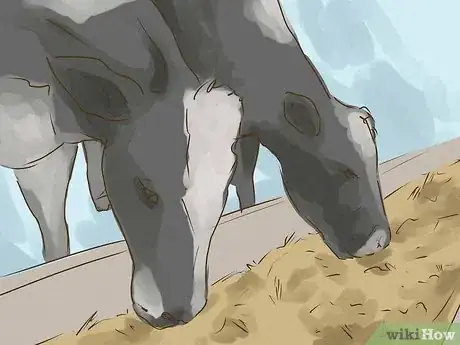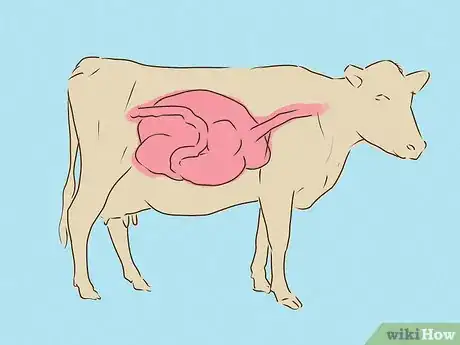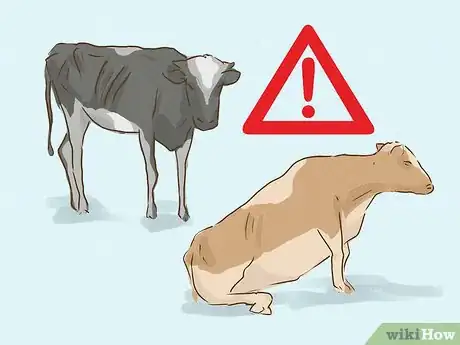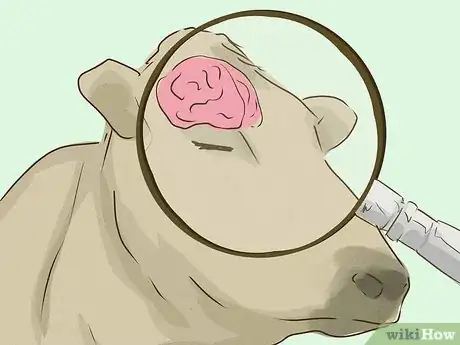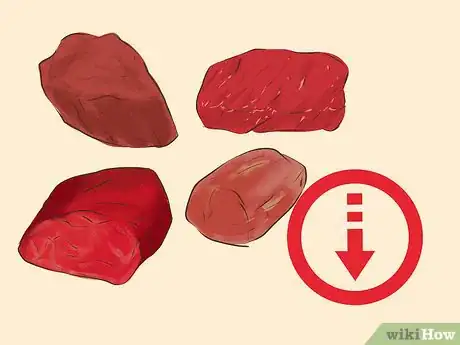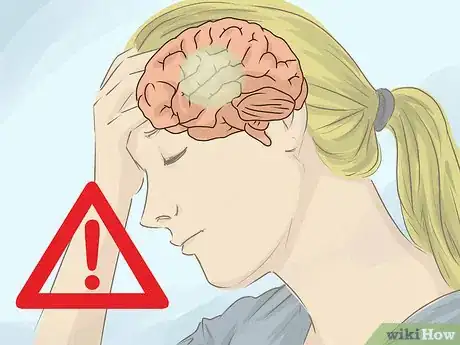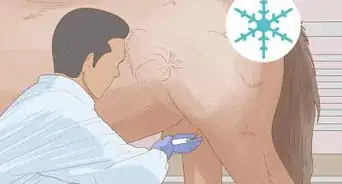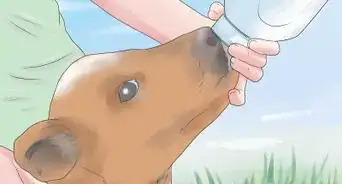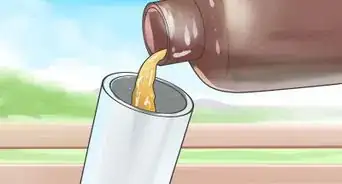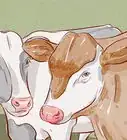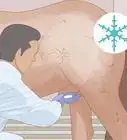This article was co-authored by wikiHow Staff. Our trained team of editors and researchers validate articles for accuracy and comprehensiveness. wikiHow's Content Management Team carefully monitors the work from our editorial staff to ensure that each article is backed by trusted research and meets our high quality standards.
There are 10 references cited in this article, which can be found at the bottom of the page.
This article has been viewed 44,799 times.
Learn more...
What is commonly called Mad Cow Disease is actually 2 different illnesses, Bovine Spongiform Encephalopathy (BSE), which affects cows, and Creutzfeldt-Jakob Disease (vCJD), which affects humans. Thankfully, both of these diseases are extremely rare today due to increased health and safety regulations. By avoiding food products that contain central-nervous-system tissues, you can largely prevent the diseases. Following some practical steps will keep both you and your cattle in good health.
Steps
Preventing Bovine Spongiform Encephalopathy (BSE) in Cows
-
1Feed your cattle non-ruminant feed. Avoid feeding your cattle feed made from the central nervous tissue of other cattle, sheep, and deer—often called ruminant. Whenever possible avoid food made in rendering plants, which often process both ruminant and non-ruminant parts.[1]
- In the U.S. it is illegal for cattle feed to contain ruminant. Look for the USDA inspector logo on your feed to know that it is in compliance with federal law.[2]
- Avoid feeding your cattle feed from other countries, which may have different or more lax rules about how feed is made.
-
2Keep ruminant parts and meat separate when butchering your cattle. Use separate equipment to process and break down nervous tissue and muscle during butchering. Label any meat for consumption after slaughter and keep it completely separate from any nervous tissue you discard.[3]
- Consult the USDA’s website to find current rules about the humane and sanitary slaughter of cows.
Advertisement -
3Contact the USDA with any questions about slaughtering your cattle. Call the USDA information hotline at (202) 720-2791 if you are unsure about butchering best practices or how to discard nervous tissue properly. They also have a searchable database of agricultural information online.[4]
- You can use the USDA’s Ask An Expert portal to submit your question to a certified agriculture expert if you cannot find the answer online.[5]
Monitoring for BSE in Cows
-
1Look for symptoms of BSE in your cattle. Keep an eye on your cattle and call your veterinarian if you notice an abrupt change in temperament, a lack of coordination, decreased milk production, or a loss of muscle tone despite normal eating habits. The condition of a cow affected by BSE will typically deteriorate rapidly over a period of weeks to months once these symptoms surface.[6]
- BSE can take 2-8 years to incubate, so it can be difficult to know when your cow was exposed to the disease. Regular veterinary check ups will help you maintain the health of your cattle.
- Many of these symptoms are also caused by more common conditions. Any sudden change in the health of a cow merits a call to your veterinarian.[7]
-
2Get any animals of concern tested by a veterinarian after death. Talk to your veterinarian about BSE testing if you have fears that your cow was infected. The only test available requires a sample of brain tissue to test for the disease and can therefore only be conducted in deceased animals.[8]
- Your veterinarian will contact the USDA or your local regulatory agency as part of testing protocol if the test is positive.
-
3Put the low risk in perspective. Understand that the risk of your cattle contracting BSE is very low. As of 2011, there were only 29 worldwide cases of BSE. This low figure is due to increased worldwide safety measures regarding feed and slaughter practices.[9]
- As long as you follow the established regulations in place for feeding and slaughtering your cattle, your risk of a cow contracting BSE is extremely low.
- There has only been 1 case of BSE in an American-born cow.
Preventing Beef-Related Creutzfeldt-Jakob Disease (vCJD) in Humans
-
1Avoid eating the central-nervous-system tissue of cows. Focus your beef consumption on normal muscle meat rather than organ meats, such as offal. In particular, avoid eating parts of the central nervous system, such as the brain, spinal cord, retinas, and tonsils.[10]
- Especially avoid eating these parts in cattle 30 months and older, as this is typically the age group affected by BSE.[11]
- Eating regular muscle meat and consuming milk poses almost no vCJD risk.
-
2Minimize or avoid beef consumption. Cut back on your consumption of beef if you find yourself very worried about vCJD. Know that you are much more likely to get vCJD through a random (and rare) genetic mutation than you are from eating contaminated beef.[12]
- The majority of cases of vCJD have occurred outside the United States. If it makes you feel at ease, cut down on your meat consumption while traveling.[13]
- The risks of a person contracting vCJD are very low and especially low from eating contaminated beef. Eating less meat for the purposes of avoiding vCJD makes sense only if it gives you peace of mind.
-
3Look for symptoms of Creutzfeldt-Jakob Disease. Consult your doctor if you notice troubling personality changes, anxiety, temporary blindness, difficulty speaking, or jerky movements. These symptoms can be caused by many more common ailments that should be considered before vCJD.[14]
- While the only definitive test for vCJD is a brain autopsy after death, your doctor can usually diagnose vCJD from a neurological exam, if needed.
- There is no cure for vCJD. Doctors focus on treating the symptoms themselves and making the affected patient as comfortable as possible.
-
4Consult a mental health professional if you can’t shake your fears. Talk to a therapist or mental health professional if you find yourself consumed with anxiety about contracting vCJD from eating contaminated beef. The practical risks are exceptionally low, and a professional can create strategies for you to manage your fears.[15]
- Find a mental health professional in your area by using a reputable online directory, such as the professional listings on Psychology Today.[16]
References
- ↑ https://www.usda.gov/topics/animals/bse-surveillance-information-center/bse-frequently-asked-questions
- ↑ https://www.nytimes.com/2005/10/05/health/to-prevent-mad-cow-disease-fda-proposes-new-restrictions-on-food-for.html
- ↑ https://www.gpo.gov/fdsys/pkg/CFR-2000-title9-vol2/pdf/CFR-2000-title9-vol2-part313.pdf
- ↑ https://www.usda.gov/contact-us
- ↑ https://www.usda.gov/ask-expert
- ↑ https://www.usda.gov/topics/animals/bse-surveillance-information-center/bse-frequently-asked-questions
- ↑ https://www.usda.gov/topics/animals/bse-surveillance-information-center/bse-frequently-asked-questions
- ↑ https://www.usda.gov/topics/animals/bse-surveillance-information-center/bse-frequently-asked-questions
- ↑ https://www.usda.gov/topics/animals/bse-surveillance-information-center/bse-frequently-asked-questions
- ↑ https://www.mayoclinic.org/diseases-conditions/creutzfeldt-jakob-disease/symptoms-causes/syc-20371226
- ↑ https://www.usda.gov/topics/animals/bse-surveillance-information-center/bse-frequently-asked-questions
- ↑ https://www.mayoclinic.org/diseases-conditions/creutzfeldt-jakob-disease/symptoms-causes/syc-20371226
- ↑ https://www.mayoclinic.org/diseases-conditions/creutzfeldt-jakob-disease/symptoms-causes/syc-20371226
- ↑ https://www.mayoclinic.org/diseases-conditions/creutzfeldt-jakob-disease/symptoms-causes/syc-20371226
- ↑ https://www.mayoclinic.org/diseases-conditions/creutzfeldt-jakob-disease/doctors-departments/ddc-20371231
- ↑ https://www.psychologytoday.com/us/therapists
- ↑ https://www.aphis.usda.gov/aphis/ourfocus/animalhealth/animal-disease-information
